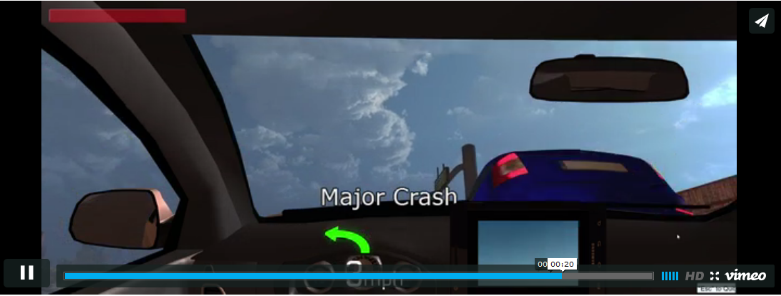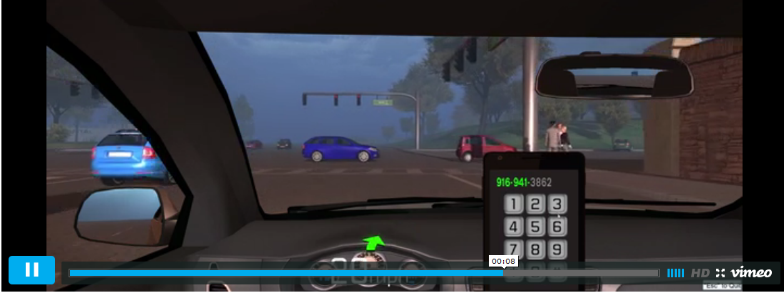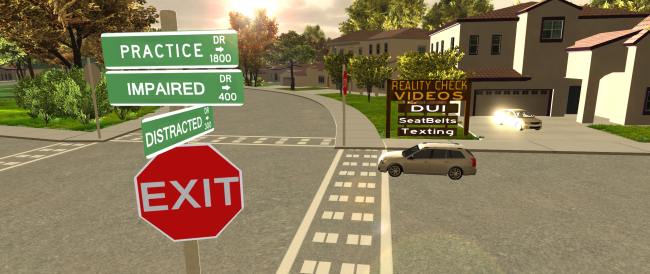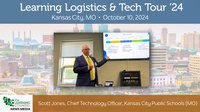Save a life, perhaps even yours. Virtual driving simulation curriculum, complete with accident consequences, such as having to visit a judge or pay for a ticket, are taking student driver’s education to a whole new level.
It may occur to you that millions of people drive on the same roads with you, potentially driving-while-distracted. For this reason, virtual driving simulators that offer practice without actual harm, should be a top interest point for extra-curriculum driver’s education offerings to students.
See some of the simulations:
Texting & Driving – Major Crash

Distracted Driving Simulation – the Near Miss

Introducing Virtual Driver Interactive
Several years ago Bob Davis, CEO of Virtual Driver Interactive, had to swerve to avoid an obstacle in the road. The incidence jolted Bob, familiar with video games, into a new realization:
Video gaming technology could be used for something important – simulation driver safety.
Thus was founded Virtual Driver Interactive. Danger situations as well as behavioral issues are addressed in a range of solutions.
 One of the products, called One Simple Decision is the world’s first simulation-based driving program designed to prevent destructive driving behaviors among teens and young adults. This innovative technology presents students with a first person account of the real life consequences of distracted and impaired driving.
One of the products, called One Simple Decision is the world’s first simulation-based driving program designed to prevent destructive driving behaviors among teens and young adults. This innovative technology presents students with a first person account of the real life consequences of distracted and impaired driving.
With One Simple Decision, students spend approximately 20 minutes on each lesson and must pass each lesson before moving on to the next. All driving lessons provide up to 70 lessons for driving and a drive time potential of over 20 hours. If standard conditions are used, each lesson can be completed in 20 minutes for a total of 4 hours for all 12 Lessons. Lessons are compiled of three distinct phases:
1) Introduction. The lesson objectives are presented in a multimedia format to introduce concepts and proper procedures to students.
2) Practice. Students are able to practice performing proper driving procedures before being scored.
3) Evaluation. The students then apply the knowledge garnered from the first two phases and are evaluated on performing the targeted driving skills.
Virtual Driver Interactive’s curriculum reflects all essential aspects of vehicle operation. In addition, many of the more detailed concepts that are often presented in non-simulation information regarding separation distances, collision avoidance, risk avoidance, and the dangers of driving while impaired by drugs or alcohol are reinforced in the simulation lessons.
The curriculum also offers a proprietary performance assessment scoring system, which continually evaluates each driver on over 80 criteria, including speed control, turns and lane changes, following distance, mirror usage, and even whether they are wearing a seat belt. Instructors see a comprehensive report for each student, providing proof that the individual mastered each skill.
Students can also further their driving experience by taking part in the Virtual Defensive Driving Course. This course reinforces the skills of the students by combining the proven driver training curriculum with actual behind-the-wheel driving in a simulated environment. The virtual driving instruction allows students to gain important potentially hazardous situations, including what constitutes hydroplaning and how to handle it.
A unique combination of sound instruction, combined with the latest high-tech tools, promotes a high "transfer of training" where skills learned on the simulator carry over to the real world.
Cost Factors
Many schools across the U.S. deliver driver’s education that is somewhat cost prohibitive. The cost of vehicles, insurance, gas and free space to train is almost making this type of training cost prohibitive. Simulation technology cuts some of those costs and enhances training.
States already Using
According to Bob Davis, the State of Georgia has several Districts using driver’s education simulation. In addition, because of Joshua’s Law passed in 2005 which takes an extra five percent for any traffic ticket, monies exist for aiding schools to purchase simulators.
Georgia is also the only State in the nation with a declining teen fatality rate, which is significant considering the swell of the millennial generation hasn’t even peaked and is larger than the population of baby boomers.
Other States and major corporations such as UPS are strong users as well. With a focus on saving more lives, this is one area of curriculum that can truly make a life-and-death difference for students.












